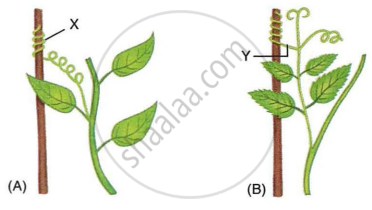Advertisements
Advertisements
Question
The tropic movement that helps the climbing vines to find a suitable support is ______.
Options
Phototropism
Geotropism
Thigmotropism
Chemotropism
Solution
The tropic movement that helps the climbing vines to find a suitable support is Thigmotropism.
APPEARS IN
RELATED QUESTIONS
Give the scientific terms used to represent the Bending of a shoot towards light.
Plant parts show two types of movements, one dependent on growth and other independent of growth Give one example which depends on growth
What happens to the moonflower
- during the daytime, and
- at night?
What is this phenomenon known as?
Distinguish between tropic movements and nastic movements in plants. Give examples to illustrate your answer.
Define hydrotropism. Give one example of hydrotropism. State whether this example is of positive hydrotropism or negative hydrotropism. Illustrate your answer with the help of labelled diagram.
A potted plant having straight parts A and B was placed horizontally on its side as shown in Figure (i). After a few days, it was observed that parts A and B of the plant acquired new positions as shown in Figure (ii).
- Name the phenomenon exhibited by the position of plant parts A and B in Figure (ii).
- Name the stimulus (other than sunlight) which causes plant part A to grow and bend upwards, and plant part B to bend downwards.

A student accidentally places her hand on the flame of the candle and quickly pulls her hand away. The flame represents:
Why do roots of halophytes show negative geotropism?
Define the following term:
Heliotropism
Study the diagrams given below and answer the following questions:

- Name the structures shown as X and Y in the figures (A) and (B), respectively.
- Write the functions performed by the structures X and Y.
- Name the phenomenon depicted and define it.
- How do the structures X and Y differ from each other?
- Give examples of the plants which show the said phenomenon.
